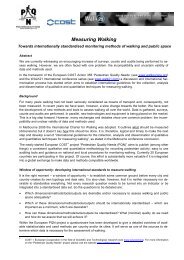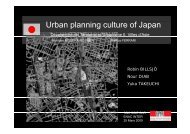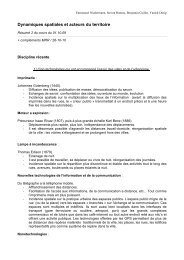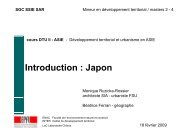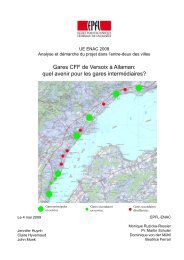http://www.foreignpolicy.com/story/cms.php?story_id=4509&print=15 sur 13 17.02.2009 11:37© Copyright <strong>2008</strong>, A.T. Kearney, Inc., <strong>The</strong> Chicago Council on <strong>Global</strong> Affairs, and Washingtonpost.Newsweek Interactive, LLC.All rights reserved. A.T. Kearney is a registered service mark of A.T. Kearney, Inc. Foreign Policy and its logo are registeredtrademarks owned by Washingtonpost.Newsweek Interactive, a subsidiary of <strong>The</strong> Washington Post Company.How to Be A <strong>Global</strong> City<strong>The</strong> <strong>2008</strong> <strong>Global</strong> <strong>Cities</strong> <strong>Index</strong>How to Be a <strong>Global</strong> City<strong>The</strong>re is no single correct path a city should tread to become global. But howshould cities that want to boost their international profile go about it? <strong>The</strong>ycould follow any of the tried-and-true models that came before them. Justlook at the various ways some of this year’s 60 global cities manage to useurbanization and globalization to their advantage.Open <strong>Cities</strong>What they look like: Large cities with a free press, open markets, easyaccess to information and technology, low barriers to foreign trade andinvestment, and loads of cultural opportunities. <strong>The</strong>y often rely on a heavyservice industry and are outward looking, rather than focused on domesticaffairs.Who they are: New York (#1), London (#2), Paris (#3)Lifestyle CentersWhat they look like: Laid-back cities that enjoy a high quality of life andfocus on having fun. <strong>The</strong>y attract worldly people and offer culturalexperiences to spare.Who they are: Los Angeles (#6), Toronto (#10)Regional GatewaysWhat they look like: Efficient economic powerhouses with favorableincentives for businesses and easy access to the natural resources of theirregion. <strong>The</strong>y attract smart, well-trained people from around the world, andthey often must reinvent themselves to remain competitive.Who they are: Hong Kong (#5), Singapore (#7), Chicago (#8)National LeadersWhat they look like: Large cities that shape the collective identity of theircountries. <strong>The</strong>y usually have homogenous populations, and their new urbanpolicies tend to evoke a shared history. <strong>The</strong>y do well in internationalbusiness, but not because they’re necessarily globally connected; in theseplaces, foreign firms can find something no other city offers.Who they are: Tokyo (#4), Seoul (#9), Beijing (#12)Policy HubsWhat they look like: <strong>Cities</strong> with outsized influence on national andinternational policy debates. <strong>The</strong>ir think tanks, international organizations,and political institutions shape policies that affect all people, and they tend tobe full of diplomats and journalists from somewhere else.Who they are: Washington (#11), Brussels (#13)Platform <strong>Cities</strong>What they look like: Large hubs in typically small countries that attract hugeamounts of investment through their strategic locations and international
http://www.foreignpolicy.com/story/cms.php?story_id=4509&print=16 sur 13 17.02.2009 11:37connections. Firms don’t set up shop in these cities to invest in the localeconomy; they move there so they can reach important foreign financialmarkets without dealing with the region’s political headaches.Who they are: Amsterdam (#23), Dubai (#27), Copenhagen (#36)© Copyright <strong>2008</strong>, A.T. Kearney, Inc., <strong>The</strong> Chicago Council on <strong>Global</strong> Affairs, and Washingtonpost.Newsweek Interactive, LLC.All rights reserved. A.T. Kearney is a registered service mark of A.T. Kearney, Inc. Foreign Policy and its logo are registeredtrademarks owned by Washingtonpost.Newsweek Interactive, a subsidiary of <strong>The</strong> Washington Post Company.<strong>The</strong> Mayors of the Moment<strong>The</strong> <strong>2008</strong> <strong>Global</strong> <strong>Cities</strong> <strong>Index</strong><strong>The</strong> Mayors of the MomentNo city globalizes on its own. But with shrewd investments and smart urbanplanning, a mayor can help turn a regional player into a global powerhouse.Here’s how three of the world’s top mayors are climbing the ladder:Klaus Wowereit Mayor of Berlin (#17)<strong>The</strong> concept of the global city isn’t lost on Klaus Wowereit. Since taking officein 2001, the popular, 55-year-old mayor of Berlin has tied his fate torebranding the city as a glamorous, artistic model of urban renewal. AndBerlin’s reputation has thrived as a vibrant, tolerant, creative metropolisunder his watch. Wowereit cites the construction of a gigantic internationalairport, the successful 2006 World Cup, and a cultural festival called “Asia-Pacific Weeks” as landmark accomplishments. His critics claim that hefocuses more on the city’s image than its crumbling infrastructure or budgetshortfalls. “We are poor but sexy,” admits Wowereit. A fun fantasy it maybe, but Berliners will probably only be willing to play the starving artist forso long.Syed Mustafa Kamal Mayor of Karachi (#57)<strong>The</strong> new mayor of Karachi is an unlikely poster child for innovative urbanplanning. <strong>The</strong> 36-year-old Syed Mustafa Kamal governs a city that’s moreoften in the news for religious violence than cosmopolitan ways. But thehard-charging Kamal is looking to change all that. He’s courting foreigninvestment, encouraging international ties, and boosting the city’s tourism.Kamal isn’t shy about his goals: He has said he wants to turn Karachi intothe “next Dubai.” His Green Karachi project aims to plant thousands of treesin the city. No stranger to Karachi’s bare-knuckled politics, Kamal isn’tletting anything stand in the way of his grand plans: He has threatened toarrest anyone who tries to cut down the new saplings.Wang Hongju Mayor of Chongqing (#59)Think Michael Bloomberg has his hands full? Wang Hongju is mayor of thefastest-growing city on the planet, one whose metropolitan area is alreadybursting at 32 million—more than the population of Iraq. But Wang isn’tletting China’s urban revolution happen under his feet. He has been knownto collect advice from citizens (for cash rewards), from mayors of sistercities such as Toronto, and even from the works of Thomas Friedman. Wanghas sought heavy foreign investment, which his administration says hastopped a whopping $3 billion in the past five years. In 2005, he claimed hisantipoverty programs had helped 3 million Chongqing residents rise out ofpoverty in the previous eight years. Wang rarely shies from reporters’questions, even about hot-button topics such as Tibet or SARS. Hisapproach, a stark departure from Communist Chinese officials of old, hasmade the 63-year-old Wang the face of a new breed of Chinese mayors.© Copyright <strong>2008</strong>, A.T. Kearney, Inc., <strong>The</strong> Chicago Council on <strong>Global</strong> Affairs, and Washingtonpost.Newsweek Interactive, LLC.All rights reserved. A.T. Kearney is a registered service mark of A.T. Kearney, Inc. Foreign Policy and its logo are registered



